|
|
|
2nd Battalion, Yorkshire Regiment (Green Howards)
The 2nd Battalion, Yorkshire Regiment (Green Howards) was in Guernsey in August 1914 when war broke out. They were ordered to return to England and landed at Southampton on the 28th of August and joined 21st Brigade, 7th Division. They proceeded to Belgium to join the BEF on the
6th of October 1914 landing at Zeebrugge. They suffered very heavy losses in the First Battle of Ypres and did not regain full strength until February 1915. They took part in the major battles of 1915 including, Neuve Chapelle, Aubers Ridge, Festubert, the second action at Givenchy and The Battle of Loos. On the 20th of December 1915 21st Brigade transferred to 30th Division. They saw action in the Battle of the Somme in 1916, the pursuit of the German retreat to the Hindenburg Line, the Arras offensive and the Third Battle of Ypres in 1917. In early 1918 they saw action on the Somme and at the Battle of the Lys, following which the army was reorganised, the 2nd Battaion absorbed the 6th Battalion on the
11th of May 1918 and transferred to 32nd Brigade, 11th (Northern) Division. They saw action in the Battles of the Hindenburgh Line and at the Armistice the Division was on high ground east of Havay.
4th Oct 1914 Orders Received
5th Oct 1914 On the Move
6th Oct 1914 On the Move
7th Oct 1914 On the Move
8th Oct 1914 On the Move
9th Oct 1914 Orders
9th Oct 1914 Anxiety
10th Oct 1914 Withdrawal
11th Oct 1914 Hostile Forces
11th Oct 1914 Orders
12th Oct 1914 On the March
13th Oct 1914 Enemy Closes
14th Oct 1914 On the March
14th Oct 1914 On the March 
15th Oct 1914 Hostile Column 
16th Oct 1914 On the March 
16th Oct 1914 Line Advanced 
17th Oct 1914 Enemy Active 
18th Oct 1914 Planning 
19th Oct 1914 Hard Fighting 
20th Oct 1914 Defensive Line
21st Oct 1914 Hard Fighting
22nd Oct 1914 Bombardment
23rd Oct 1914 Under Fire
24th Oct 1914 Enemy Break Through
25th Oct 1914 Enemy Break Through
26th Oct 1914 Forced Back
27th Oct 1914 Orders Received
28th Oct 1914 Artillery Active
29th Oct 1914 Hard Fighting
30th Oct 1914 Out of the Trenches
30th Oct 1914 Hard Fighting
31st Oct 1914 Hard Fighting 
18th Dec 1914 Attack 
21st Sep 1915 Orders 
1st of January 1916 Move 
1st of January 1916 Night-time Shelling
2nd of January 1916 Direct Hits 
13th of January 1916 5th Division in Reserve
25th May 1916 Reliefs
26th Aug 1916 Reliefs Trenches Festubert Sector 21.00. 18th Battalion. DLI Less C Co. which remained in O.B.L right relieved 15th West Yorkshire Regiment. B Co. front line Right, D Co. front line Left. A Co. O.B.L Left. 16th West Yorks Battalion on our Left. 2nd Yorks Battalion on our Right. No casualties. Later in night 2 casualties.
18th DLI war diary WO95/2361/1
27th Aug 1916 Artillery Active 18th Durhams hold Trenches in Festubert Sector .05.05. German deserter gave himself up coming into B Coy. lines at No 1 Island. Day showery but clear. 16.30. German artillery fire H.E. shrapnel over Festubert Road South of Barnton from 4.30pm, 5.30pm. 2nd Bedfords relieved 2nd Yorks. during night. 18th DLI war diary WO95/2361/1
31st July 1917 In Action 
2nd Aug 1917 Message of Congratulation 
22nd Aug 1917 Reliefs 
13th Apr 1918 In Depth
19th Apr 1918 Reliefs Complete 
20th Apr 1918 Quiet 
21st Apr 1918 Quieter 
22nd Apr 1918 Gas 
23rd Apr 1918 Gas Shells 
24th Apr 1918 Gas Shells 
If you can provide any additional information, please add it here.
|
| Want to know more about 2nd Battalion, Yorkshire Regiment (Green Howards)? There are:5282 items tagged 2nd Battalion, Yorkshire Regiment (Green Howards) available in our Library There are:5282 items tagged 2nd Battalion, Yorkshire Regiment (Green Howards) available in our Library 
These include information on officers, regimental histories, letters, diary entries, personal accounts and information about actions during the Great War.
|
|
Those known to have served with2nd Battalion, Yorkshire Regiment (Green Howards) during the Great War 1914-1918. - Adams David. Pte. (d.29th Sep 1918)
- Bielby Arthur. Pte. (d.14th Feb 1917)
- Birch MC. William Claud Kennedy. Mjr. (d.5th January 1918)
- Brown John Thomas. Pte. (d.8th July 1916)
- Churchill Mark. Pte. (d.8th Jul 1916)
- Cocking Thomas. Pte. (d.8th July 1916)
- Cocking Tom. Pte. (d.16th July 1916)
- Collinson Thomas Gibson. Pte. (d.1st July 1916)
- Connolly John Patrick. Pte. (d.8th July 1916)
- Coulson John. Pte. (d.22nd Nov 1916)
- Coyle George. Pte, (d.1st Jul 1916)
- Denby John Edwin. Pte (d.16th May 1915)
- Dickinson Joseph Bradley. Pte. (d.13th Jan 1915)
- Edwards George. Pte. (d.15th Jun 1915)
- Fishpool CdG. Charles Henry. 2Lt.
- Geraghty John. Pte.
- Hanson Harold Vickerman. CQMS.
- Hepburn William Stephen. L/Cpl. (d.8th July 1916)
- Herlingshaw William. Pte.
- Jackson Varo. Pte. (d.27th Oct 1918)
- Mills William Ernest. Pte. (d.6th Nov 1914)
- Milson DCM. William James Denton. Sgt. (d.4th July 1916)
- Muncaster Robert Wilson. Pte. (d.6th Nov 1918)
- Palmer DSO, MC, PSC. Alexander Edward Guy.
- Partridge William. L/Cpl. (d.29th May 1918)
- Pollard Albert. L/Cpl. (d.12th Mar 1915)
- Roberts James. Pte. (d.8th May 1918 )
- Robinson Horace Edward. Pte. (d.28th Mar 1918)
- Robson Thomas Anthony. Pte. (d.5th May 1917)
- Rose Frederick. Drm. (d.4th March 1917)
- Rowan John. Pte. (d.18th Oct 1916)
- Sample Alfred James. Pte. (d.2nd Apr 1917)
- Smith William Spence. Pte. (d.13th Jan 1916)
- Thompson James. Pte. (d.22nd Oct 1914)
- Waterfield William Edwin. Lt
- Watts Thomas Henry. Pte.
- Wilkinson Charles Robert. L/Sgt. (d.6th May 1918)
All names on this list have been submitted by relatives, friends, neighbours and others who wish to remember them, if you have any names to add or any recollections or photos of those listed,
please Add a Name to this List
Records of 2nd Battalion, Yorkshire Regiment (Green Howards) from other sources.
|
|
- The Wartime Memories Project is the original WW1 and WW2 commemoration website.
- 1st of September 2023 marks 24 years since the launch of the Wartime Memories Project. Thanks to everyone who has supported us over this time.
|
Want to find out more about your relative's service? Want to know what life was like during the Great War? Our
Library contains many many diary entries, personal letters and other documents, most transcribed into plain text.
|
Looking for help with Family History Research?
Please see Family History FAQ's
Please note: We are unable to provide individual research.
|
|
Can you help?
The free to access section of The Wartime Memories Project website is run by volunteers and funded by donations from our visitors.
If the information here has been helpful or you have enjoyed reaching the stories please conside making a donation, no matter how small, would be much appreciated, annually we need to raise enough funds to pay for our web hosting or this site will vanish from the web.
If you enjoy this site
please consider making a donation.
Announcements
- 10th April 2024
Please note we currently have a massive backlog of submitted material, our volunteers are working through this as quickly as possible and all names, stories and photos will be added to the site. If you have already submitted a story to the site and your UID reference number is higher than 263893 your submission is still in the queue, please do not resubmit.
Wanted: Digital copies of Group photographs, Scrapbooks, Autograph books, photo albums, newspaper clippings, letters, postcards and ephemera relating to the Great War. If you have any unwanted
photographs, documents or items from the First or Second World War, please do not destroy them. The Wartime Memories Project will give them a good home and ensure that they are used for educational purposes. Please get in touch for the postal address, do not sent them to our PO Box as packages are not accepted.
|
We are now on Facebook. Like this page to receive our updates, add a comment or ask a question.
If you have a general question please post it on our Facebook page.
|
World War 1 One ww1 wwII greatwar great battalion regiment artillery
Did you know? We also have a section on World War Two. and a
Timecapsule to preserve stories from other conflicts for future generations.
|
|
|
Pte. John Coulson 2nd Btn. C Coy. Yorkshire Regiment (d.22nd Nov 1916) John Coulson was killed in action on the 22nd of November 1916, aged 36. Buried in Abbeville Communal Cemetery, Somme, France, he was the husband of Elizabeth A. Coulson, of 29 Stainton St., West Hartlepool
|
Pte. Thomas Cocking 2nd Btn. Yorkshire Regiment (d.8th July 1916) My great uncle, Tom Cocking of 2nd Battalion, The Princess of Wales Own Yorkshire Regiment, died in the action of 8th of July 1916.
His remains are one of seventeen soldiers from the action that have never been found. He is memorialised at the Thiepval monument.
My family never spoke of him, and it was purely by accident that I learned of his sacrifice. After almost one hundred years I was the first member of his family to visit Thiepval and the area where Tom lost his life, and I dearly hope that one day his remains will be found and laid to rest.
I am more than willing to provide a DNA sample to assist that search should I ever be required to do so.
|
Alexander Edward Guy Palmer DSO, MC, PSC. 2nd Btn Yorkshire Regiment (Green Howards) Alexander Palmer served with 2nd Battalion, Yorkshire Regiment.Dominique de Gaultier de Laguionie
|
Pte. Robert Wilson Muncaster 2nd Btn. Yorkshire Regiment (d.6th Nov 1918) Robert Muncaster was my Grandad's brother.
Grandad was 11 when his brother was killed at age 26. When Grandad had his first son (my uncle) he raced to the registry office before my Gran could stop him and named him Robert after his dear brother.
I only just found this out today 11th of November 2018.
|
Pte. John Geraghty 2nd Battalion, C Coy. Yorkshire Regiment John Geraghty was taken prisoner on 25th of September 1915 at Vermelles during Battle of Loos. he was returning to his trench having gone for supplies and on return found it had been overrun by the Germans
|
2Lt. Charles Henry Fishpool CdG. 9th Btn. York & Lancaster Regiment Charles Fishpool joined up in Dec 1915 as a Private with the 2nd Yorkshire Regtiment. In Sept 1916 he joined the 9th York & Lancs and gained the rank of Sergeant in May 1917. He was commissioned Temp 2nd Lt and was awarded the Croix de Guerre.
|
Pte. William Herlingshaw 2nd Battalion Yorkshire Regiment William Herlingshaw was wounded in battle and discharged on 5th of June 1916 as being no longer physically fit for war service.
|
Pte. James Roberts 2nd Battalion Yorkshire Regiment (d.8th May 1918 ) James Roberts was 18 years old.
|
Mjr. William Claud Kennedy Birch MC. 2nd Btn. Yorkshire Regiment (d.5th January 1918) 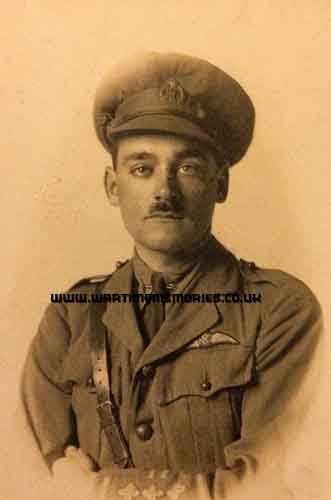 Major William Birch of the Yorkshire Regiment, was seconded to the Royal Flying Corp and got his wings at the Grahame-White school, Hendon in December 1912. He then joined No. 3 Squadron, which flew to France at the start of the war. He saw active service as a pilot through 1914 and 1915, being mentioned in dispatches twice. On 14th of January 1915 his Morane aircraft was hit by enemy fire and he landed east of the lines. He took to the countryside and made it to Flushing on the Dutch coast. Disguised as Fireman James Buckle, he worked his passage to England and was back flying in combat on 1st March 1915. In June of that year, he was back in Britain with training squadrons but was back in combat in 1916. In 1917, he returned to the Yorkshire Regiment as Captain and was promoted to acting Major. On 5th of January 1918, his men were sheltering in Hedge Street tunnel when an electrical fire was noticed and it quickly took hold. Major Birch escaped but when he realised men were still trapped, he returned to the tunnel and was not seen alive again. The fire burnt with such intensity that the tunnel had to be closed off to stop it spreading and his body was discovered when the tunnel was reopened. He is buried at Railway Dugouts Burial Ground (Transport Farm) Belgium. Claud, as he was known to the family, was my maternal grandmothers brother.
|
Pte. Thomas Henry Watts 2nd Btn. Yorkshire Regiment My grandfather, Thomas Watts, was born in Thornaby, Stockton On Tees in 1894 and was of mixed Welsh and English parentage. On leaving school he worked in the shipyards and also the iron foundries. It was a hard life with little reward. In July 1913, at the age of 19, he enlisted in the army, perhaps seeing it as a way to better his lot in life. Work was getting scarcer at that point in the North East of England and joining the army would at least ensure shelter and food. He served with the 2nd Battalion, Yorkshire Regiment, then known as Alexandra, Princess of Wales Own Yorkshire Regiment. He saw active service in France between 1914 and 1917. In April 1917 he suffered gunshot wounds and was sent to the pioneering 1st Eastern General Hospital in Cambridge for treatment. He was considered unfit for further war service and was discharged from the army in July 1917. As well as gunshot wounds he was also exposed to toxic gas. He suffered thereafter with lung and heart problems and died from related disease in 1928 at the age of 34.
|
Pte. David Adams 2nd Btn. Yorkshire Regiment (d.29th Sep 1918) My great grandfather, David Adams, was the oldest boy of six in a family of nine children. He worked in the local colliery before being called to war, by which time he had married and had two children, a daughter and a son. He never really got to know his children, particularly his son, Joseph, my maternal grandfather, who was born very shortly before David was sent to France and he sadly never returned.
Grandad Joe never forgot his father despite his mother marrying again shortly after the end of the war. As proof of this remembrance he sported a homemade tattoo on his arm with David's death date on a cross. It was not until I was doing the research that I understood the significance of this date as it was not something spoken about in the family.
My mother is currently in possession of David's Victory war medal having received it when Grandad died.
|
Pte. William Spence Smith 2nd Btn. Yorkshire Regiment (d.13th Jan 1916) My mother's uncle Bill Smith was a merchant seaman before joining up in 1914 when he was in his late thirties. He was born in Middlesbrough and enlisted there, when home from sea he stayed with his brother's family in Normanby. He was killed on 13th of January 1916 when the Somme was a quiet sector. In the war diaries nothing of note happened that day. He is buried in the Carnoy Military Cemetery and his name is on the Normanby Village Memorial.
|
Pte. Thomas Gibson Collinson 2nd Btn. Yorkshire Rgt. (d.1st July 1916) My great-grandfather, Thomas Collinson, was killed on 1st July 1916 at the Somme. He was a professional soldier. His remains were not found/identified and his name is listed on the Thiepval Memorial.
|
Pte. John Thomas Brown 2nd Btn. Yorkshire Regiment (d.8th July 1916) Private John Thomas, 20622, served with the 2nd Battalion, Alexandra, Princess of Wales's Own (Yorkshire Regiment). He was killed in action on 8th July 1916, aged 23.
John was born in Crakehall and enlisted in Leyburn. He was a resident of Patrick Brompton, Bedale. He was the son of Joseph and Ellen Brown of Patrick Brompton, Bedale, Yorks.
John has no known grave and is commemorated on the Thiepval Memorial, Somme, France. May he rest in peace.
|
Pte. Arthur Bielby 2nd Btn. Yorkshire Regiment (d.14th Feb 1917) Arthur Bielby served with the 2nd Btn. Yorkshire Regiment.
|
Sgt. William James Denton Milson DCM. 2nd Battalion Yorkshire Regiment (d.4th July 1916) 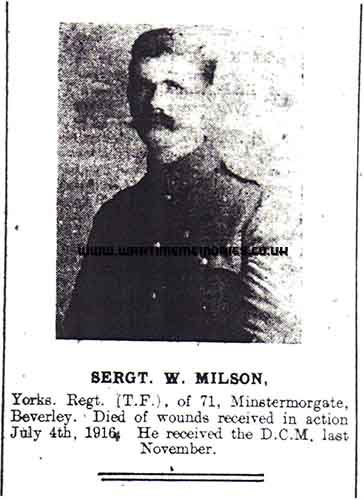 My great uncle Wil Milson won his DCM whilst the 2nd Battalion of the Yorkshire Regiment were near Bethune in the Loos sector,in November 1915, an area full of mine works.
The Regiment's history notes that both the British and the Germans were attempting to explode mines under each other's trenches. At midnight on the 29th the 2nd Battalion were busy endeavouring to explode mines before the Germans exploded theirs, and laid charges timed to explode at 4am on the 30th and then they planned to move up across quickly, given the torrential rain, a very muddy No Mans Land. As there was no response after the explosions for several hours an advance party of some 30 men went to consolidate the trench taken from the Germans only for the Germans to blow another small mine which buried about 25 men. My Uncle, assisted by a Corporal Wilson, organised a rescue party under heavy shell fire and supervised and assisted in rescuing the men, despite German sniper fire and a heavy bombardment. They worked so well that 19 of the men were rescued although 6 remained missing.
The 2nd Battalion The Yorkshire regiment were part of the 21st Brigade of the 30th Division at the Battle of the Somme at the southernmost sector, whose objective on the 1st July 1916 was to capture Montauban from the Germans. The Battalion were in support of the advance party, who were the 2nd Liverpool and 4th Manchester Pals. Given the effectiveness in this sector of the preliminary Artillery barrage before the attack, the advance party had little opposition as it crossed No Mans Land. However when the 2nd Battalion of the Yorkshire regiment advanced a German machine gun unit positioned to their left in the Railway, or Carnoy, Valley created an enfilade fire which cut to pieces the 2nd Yorkshires to the point that very few managed to get across No Mans Land. Amongst those was my Great Uncle, Sergeant Milson, who was badly wounded. He was sent to a Casualty Clearing Station behind the lines, at Corbie, where he died from his wounds on 4th July. He is buried at Corbie Communal Cemetery Extension. 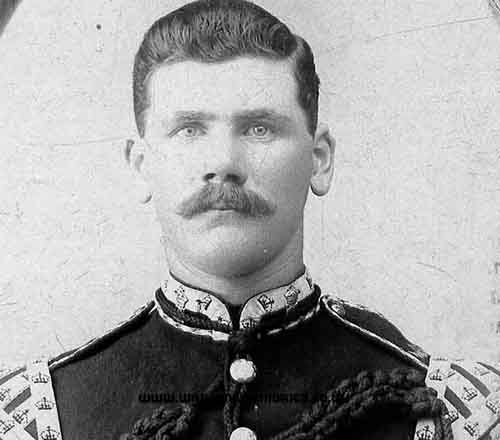 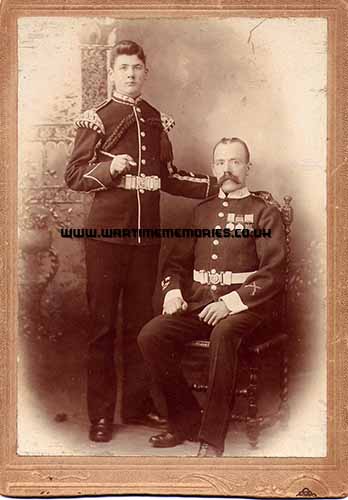
|
CQMS. Harold Vickerman Hanson 2nd Btn. Yorkshire Regiment 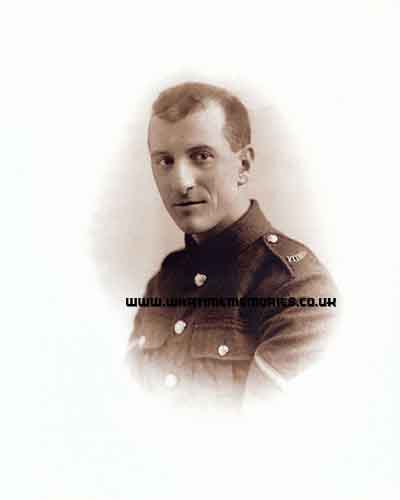 The Great War cast its shadow over my grandfather's life even before it began, because in August 1914 Harold Hanson went on a Cook's Tour of the Rhineland. It might be thought that this was not the best time to visit Germany, but the holiday had been booked months beforehand when the European situation had appeared quite stable.
Everywhere the British party travelled they became increasingly alarmed at the sight of large-scale movements of German troops, which their German guide tried to reassuringly describe as 'just manoeuvres'. However, it was quite evident that Germany was mobilising for war, and the tourists were relieved when they left for home a day or two before the outbreak of hostilities, otherwise they would have faced spending the war in a Civilian Internment Camp in Germany.
My grandfather, being a Yorkshireman, volunteered to join the King's Own Yorkshire Light Infantry and passed his army medical examination as A1 - i.e. fit for combat duty, in spite of the fact that his eyesight was so poor he had resigned from his school cricket team at the age of 13 because he could no longer see the ball!
My grandfather was sent to a huge army camp on Salisbury Plain for his basic training where he vividly remembers bayonet practice on rope-hung sacks of sawdust, and the drill sergeant barking out the order 'And before you withdraw the bayonet - give it a twist!'
One winter's morning in the 1970's, I was volunteered by my office manager to help him light the central heating boiler when the stoker, a local man, hadn't turned up. My task was to chop firewood for which I was handed a World War One bayonet, which was so razor sharp that with very little effort I soon had a large pile of firewood ready. Remembering my grandfather's training, I shuddered to imagine thrusting this lethal weapon into a human body!
Not long after the commencement of my his training, a very unpleasant event occurred. Fresh rations suddenly and mysteriously disappeared, to be replaced by what the army called hard tack - large square biscuits, nicknamed dog biscuits by the men. The absence of fresh food was entirely owing to the incompetence and indifference of the military authorities - after all, the recruits were not stationed in a remote outpost of the British Empire, but in south-west England!
After a few days of this treatment, rioting broke out in one of the barrack huts which were grouped around a large square quadrangle. The riot quickly spread to all the other huts. Furniture and windows were smashed and the dog biscuits used as projectiles, being hurled around indiscriminately. My grandfather, not wishing to participate in the riot or to be hit by one of the fearsome biscuits, dropped to his knees.
He had no sooner done so than one of his comrades received one of the biscuits full on the forehead, causing a deep gash from which blood spurted. The man was knocked unconscious by the blow, and fell to the floor at the side of my grandfather, who crawled to one of the windows. Looking out he saw a group of officers standing huddled together in the middle of the quadrangle, heads together, discussing the deteriorating situation. Every now and again, one of the officers would turn and look apprehensively at the huts full of rioting men. Eventually the officers dispersed without attempting to approach any of the huts to remonstrate with the recruits - they were obviously afraid to do so, the men being in such an ugly mood.
However, the riot had the desired effect because first thing next morning there was fresh food for breakfast - and plenty of it! No disciplinary action was taken against any of the rioters - the military authorities preferring to pretend that the riot had never happened. Doubtless they realised that the men had been pushed too far - and they wouldn't want the newspapers getting wind of the affair!
It was during this time that my grandfather's deficient eyesight was finally discovered - on the firing range! Each recruit had been given a numbered target to aim at, and the accuracy was plotted by monitors. My grandfather had been firing away for a few minutes when the Captain in command of the firing range came up behind him and demanded 'Which target number are you aiming at?'
My grandfather looked round in some surprise and replied 'I'm aiming at my designated target - No. 2.'
The Captain then said 'Well my monitors tell me that your shots are hitting target No. 4. You had better get along to the M.O. (Medical Officer) and have your eyesight tested.'
The M.O. was going to write out a medical discharge there and then, but it had to be countersigned by a second M.O. who, being a brusque, no-nonesense type said “Oh there’s no need to discharge this man, he's quite fit enough for non-combat duties.'
Accordingly, my grandfather's civilian record was examined and he was awarded the rank of C.Q.M.S. (Company Quatermaster Sergeant) and then posted to Alexandra, Princess of Wales's Own Yorkshire Regiment a.k.a. The Green Howards. This meant that my grandfather had to bid farewell to the other 29 comrades in his barrack hut, everyone of which, my grandfather subsequently learned after the war, had been either killed or wounded. Not one had come through the war unscathed.
As C.Q.M.S. my grandfather's duties were varied. On one occasion for instance, he was ordered to oversee a group of Conscientious Objectors who had been set to work digging latrines (toilets). On another occasion he was required to dispose of a huge quantity of discarded uniforms which were dumped on his quadrangle in large rotting heaps. This didn't please his Colonel who demanded 'What's all this bloody mess, Quarters?'
My grandfather's response was to ask the Colonel to look more closely at the heaps, upon which he exclaimed 'Good Heavens, they're moving!' The heaps of rotting uniforms were so heavily infested with lice that the constant wriggling of the creatures was making each pile slowly and rhythmically rise and fall, which gives some indication of the appalling conditions in the front-line trenches.
From time to time my grandfather received inducements to sell army supplies on the black market, but being a man of scrupulous honesty he always firmly rebuffed such overtures.
With the declaration of the Armistice, my grandfather looked forward to demobilisation, and to be re-united with my grandmother, whom he had married a year previously. However, his hopes were dashed when he was told he was to be posted to Dublin for several months as part of the British Forces garrisoned there, in order to counter the activities of the Irish Nationalists.
My grandfather found the atmosphere in Dublin was poisonous with hatred towards the British to such an extent that off-duty soldiers were under strict orders not to walk through the city streets in groups of less than three. Accordingly, one day he was walking along with two other sergeants when, passing two Irishmen on the pavement, one of the Irishmen made a derogatory remark about the British. Unfortunately, one of the other two sergeants had a quick temper and spontaneously lashed out with his fist, knocking the offending Irishman flat on his back. This was the signal for every Irishman in the vicinity to pounce on the three sergeants, and things would have gone very badly for them had not providence been on their side in the form of a Public House on the corner of the street which just happened to be full of off-duty Seaforth Highlanders, who liked nothing better than a good scrap, and on hearing the rumpus in the street outside, they piled out of the pub, and very soon the entire street was full of men knocking the daylights out of each other.
My grandfather took this welcome intervention as an opportunity to make his escape because, although he was a good amateur boxer, he boxed at Bantam Weight, so he was no match for a burly Irishman. However, he was left with the prospect of making his own way back to the barracks along streets where every British soldier was a marked man, and he couldn't afford to hurry or look nervous - fortunately the journey passed without incident.
Although my grandfather did not enjoy his sojourn in Dublin, there was one bright note. The food in the sergeants' mess was prepared by local women, instead of the usual army cooks, and I remember my grandfather telling me that these ladies cooked some 'wonderfully tasty meals' - so at least he was well fed!
Following eventual demobilisation, my grandfather expected to get his old job back without any trouble because the Government had made it very clear to employers from the very beginning of the War that jobs of men serving in the forces were to be kept open for them on their return. However, in spite of having given exemplary service, my grandfather found his employers strangely reluctant to re-employ him. As my grandmother and baby daughter (my mother) had been living with my great-grandparents during the war, my grandfather had to find both a home and an income, and jobs at the time were hard to come by. Therefore he had to swallow his pride and turn to a Veterans' Association who were successful in applying pressure on his employers. He later learned that his job had been taken by a man who had not served in the war but was a relative of one of the Company Directors. This episode graphically illustrates the difficulties soldiers faced when returning to civilian life.
While clearing out my grandparents' bungalow after their deaths within a month of each other, I came across a momento from my grandfather's army days - the casing of a hand grenade that both my mother and myself had played with as children. When a scrap metal dealer came, I tossed the grenade on to the pile of metal objects, remarking with a smile, 'Here's an extra bit of metal for you.' I laughed at his evident alarm and reassured him, 'It's quite harmless, it's hollow inside.' He still looked very dubious, but he took it with the rest and drove away.
That same evening my mother received a phone call from a police sergeant who asked her if there was any more live ammunition lying around the property. Apparently the scrap metal dealer had handed in the grenade at a local police station and the Bomb Squad had successfully detonated it.
As a child I had, from time to time, considered removing the pin of the grenade in order to ascertain how the pieces of the casing fitted together. I had always been deterred from this course of action by reasoning that the pin fitted so tightly that I might not be able to restore it to its original position. Of course, if I had pulled out the pin I should not now be writing this account, and many years after the signing of the Armistice, the Great War would have claimed yet another casualty.
.jpg) .jpg) 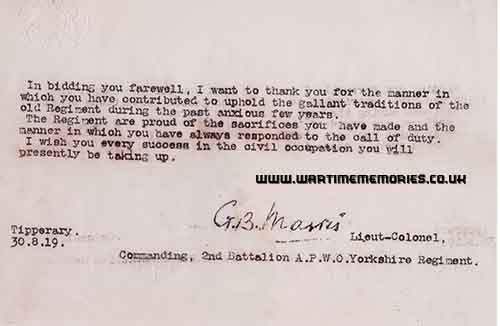
|
Pte. William Ernest "Sonny" Mills 2nd Battalian Yorkshire Regiment (d.6th Nov 1914) William Mills is my great uncle Sonny. He had two other brothers, Herbert (known as Tom) and Robert (Bob). Am still researching his details as my granddad (Tom) maintained that his brother Sonny was only 16 when he joined up and was killed. Sonny disembarked in Belgium 5th of October 1914 and died a month later.
|
Pte. Alfred James Sample 2nd Battalion Yorkshire Regiment (d.2nd Apr 1917) Jim Sample served with the 2nd Btn, Yorkshire Regiment.
|
L/Cpl. Albert Pollard 2nd Btn. Yorkshire Regiment (d.12th Mar 1915) Arthur Pollard is remembered on the Le Touret Memorial.
|
Recomended Reading.Available at discounted prices.
|
|
|


Site Home
Great War Home
Search
Add Stories & Photos
Library
Help & FAQs
Allied Army
Day by Day
RFC & RAF
Prisoners of War
War at Sea
Training for War
The Battles
Those Who Served
Hospitals
Civilian Service
Women at War
The War Effort
Central Powers Army
Central Powers Navy
Imperial Air Service
Library
World War Two
Add Stories & Photos
Time Capsule
Help & FAQs
Glossary
Our Facebook Page
Volunteering
News
Events
Contact us
Great War Books
About
There are:5282 items tagged 2nd Battalion, Yorkshire Regiment (Green Howards) available in our Library